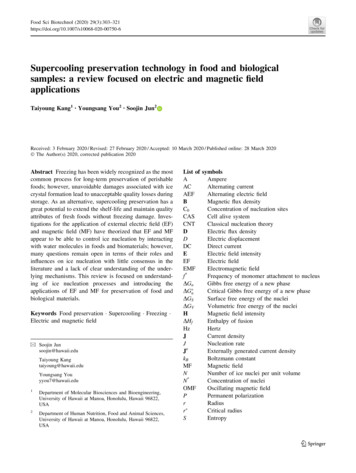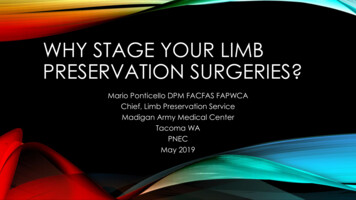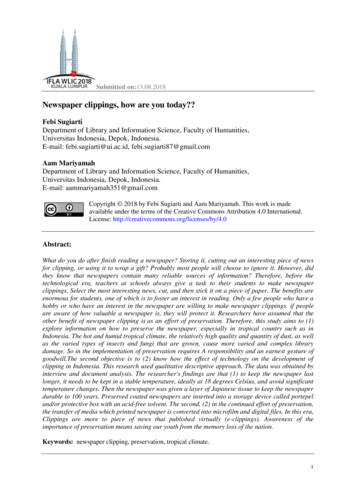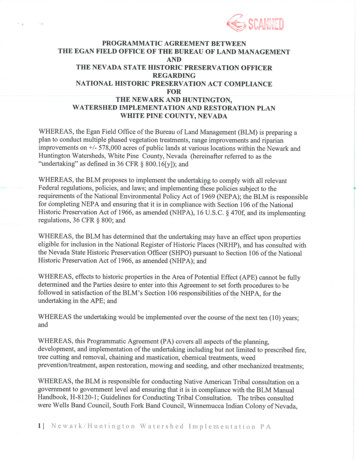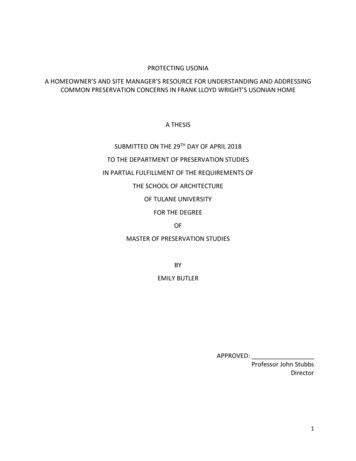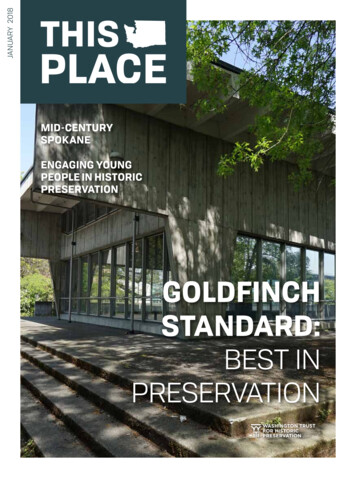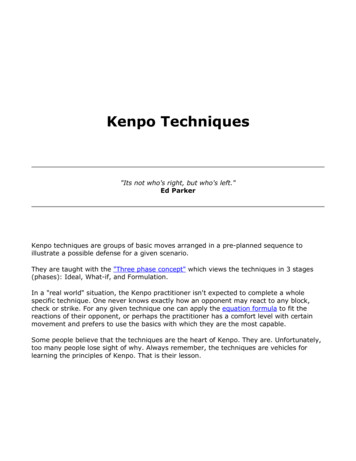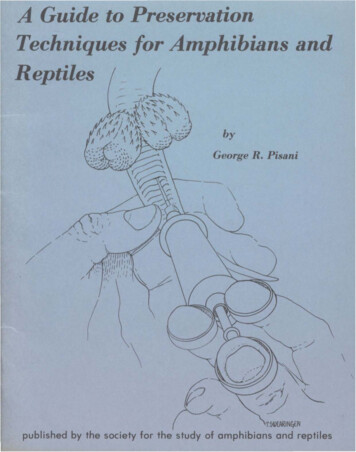
Transcription
A Guide to PreservationTechniques for Amphibians andReptilesbyGeorge R. Pisani.///\
A GUIDE TOPRESERVATION TECHNIQUESFORAMPHIBIANS AND REPTILESGeorge R. PisaniMuseum of Natural Hi storyUniversity of KansasLawrence. Kansas 66044IllustrationsbyPatricia May and Tom SwearingenMuseum of Natural HistoryUniversity of Kansas
Tab 1e of ContentsIntroduction . . . .Field NotesKill i ng of SpecimensFixing . . . . . . .Domestic Shipment.13International ShipmentStorage and Labelling15Color Preservation202223literature CitedINDEX . . . . . .17
INTRODUCTIONOver the years, several; nformative works descri bing the preservationof amphibians and reptiles have been published. Most of these have beenintended for relatively limited distribution by the institutions or individuals publishing them. This fact, coupled with new laws pertainingto syringes and certain drugs used for k.illing specimens. warrants anadditional treatment of the subject. This article is an attempt to combine a complete survey of current techniques with a page size that theindi.vtdual collector can conveniently carry in the field.In an age when so many wild species and areas of suitable habitat are atUte threshold of extermination, it seems advisable at the outset to include aplea for conservation in this booklet. Current museum collections containexcellent samples of various North American species of reptiles and amphibiansfrom certain areas within their ranges. In these instances, it is a needlesswaste to co1lect and preserve additional material when this will not addappreciably to our knowledge of these creatures. I am not referring tosuch collecting as may be associated with the compiling of a synopticteaching collection by a school or to collection of specimens needed fora particular aspect of re'search. but rather to the capture and preservationof animals simply to amass a collection which may never be used for scientificor educational purposes. There are numerous geographic areas, including severalin orth America. in which the amphibians and reptiles are poorly known.Collections. from these areas can add measurably to our herpetologicalknowledge. Persons wishing to learn of the desirability of specimensfrom particular areas should consult with herpetologists at nearbyuniversities, museums, zoos. etc.I would like to express my thanks to Woodrow W. Barber, Hobart M. Smith.WUliam E. Ouellman. Joseph T. Collins. Clarence J. McCoy. and GeorgeIann.rone for furnishing helpful material and/or advice and to Phyllis Shaffer,Judy Hamilton. Leanne Johnson. and Ginger Stiggins for typing assistance.Thanks are also expressed to Jaime Villa for preparing much of the "International Shipment" section.
Specimens not accompanied by data identifying the collection localityare virtually useless to scientific investigators. The more data availablefor a specimen, the greater its value in research. Hence, keeping accurate,complete field notes is necessary. 1any times, data felt to be trivial atthe time of collection may prove to be quite useful when many observationsare pooled. Field notes should be written in waterproof ink. ("Pelikan u brandis preferred by many) using only one side of each page. Several brands ofwaterproof ink will "runll if alcohol is accidentally spilled on the page.hence care should be used in selecting ink. A worthwhile technique is tocarry a small notebook for on-the-spot data taking. Then transfer thesedata into the permanent field notes as soon afterward as possible.The following is a representative outline of data included in fieldnotes (numbers refer to those in figure la):1.Local i ty- Do not record 1oca 1 ity with reference to businessestab 1i shments . Use towns or mapped roadways; determi ne di stancefrom an automobile odometer (if available), or estimate distancecarefully from maps. It is not unusual for roads to be rerouted.renumbered or both. It is therefore advisable to refer to roadsindicated in a good atlas to which future reference can be made.In the U. S. the American Highway Atlas (Gousha Co . Chicago) issuitable. If collecting in areas remote from roadways, locate thecollecting site as accurately as possible from U. S. GeologicalSurvey topographic maps. Collectors in foreign countries shouldtry to obtain accurate. detailed maps of the areas in which theyare working. Elevation of the locality should also be recordedwhenever possible.2.Date- Always write out the name of the month, or indicate month bya Roman numeral; 6-10-71 could refer either to June 10th or October 6th.3.Name(s) of all collector(s) present.4.Time of collecting.
fig. lal"\Il. \Y i."km,,(,.r; !,.,!"." F.lf.7,L IIH"23/Y1,,19,, 28·- '"'P",j.i,/O,j",-,C.li, "CoR. A,.ill.11af" A/,JJ"Lrtlkn.a;a.e.r:I. l.fI!.miUIJ,!,/'",iJr r 'f-'!i(),'h d.,1(I.#{!f,/,. f . !'c,, ,.f.,j.SI. /,a., a.do,i,/.H'O,,L".i, ;;c" "'---, "4"" l r.y :/:.F,f, r.'dP'W,'fA (Jl\6" !." -t,(II f,',,",,II.'I.,/',.1.,1.;/ g"'['L,I,I ""{, .-/;7,; ,.,m,i/'. " ./,. ,;."" ,{,.- ,,6 '''' t,m "'/, . I,, ,,tf,,,d tI.J .{.I, "" t. ;.1,.1 ,,;.,,To tI.1""p.t-I.' .1., hu u"';', Y.tJ./,I ,k fo?,IMf. m I 'c21"",/fig.lbGRP 9000
5.Air temperature and other appropriate weather notes- It is oftenuseful to note existing cloud cover and moisture conditions. aswell as general weather conditions preceding the collection.6.Species- List all species collected plus the number collected ofeach. followed by species which may be observed but not collected.Accurate color notes are a worthwhile inclusion. especially whencollecting in regions having a poorly known herpetofauna. It isalso worthwhile to tak.e accurate color notes when an atypicallycolored individual of a well-k.nown species is encountered.7.Microhabitat of species collected and any significant behavior(courtship. defensive display, etc.) observed.8.Field number- It is useful to carry a series of numbered field tagson collecting trips. These should be printed on heavy paper inpermanent ink. Satisfactory tags can also be made with one ofthe commercially available label makers that imprint plastictape. Thread can be sewn through the numbered tags, but thebacking on the tape should not be removed. Avoid using coloredthread. or thread made from synthetics such as nylon, which maybe destroyed by preservatives. White, cotton carpet thread issuitable for tagging. After threading the tag, tie a small knotin the string as shown in figure lb. Each specimen should beassigned its own number, which greatly simplifies the task ofkeeping specimens and localities associated. Testes, stomachcontents. photos, tape recordings, etc. are assigned the samenumber to increase efficiency in future analyses. Field tagsshould be securely tied (with a square knot) to specimens asillustrated in Plates 1 and 2. Lizards possessing femoral poresshould be tagged by knotting the string below the knee; thisavoids covering the pores with string. Tags in the field seriesshould be numbered independently from the catalog series discussedin a later section.
Of the above data, numbers 1 (locality), 2 (date), 3 (name(s) ofcollector(s), and 8 (field number) represent the minimum data which shouldbe recorded. If specimens are donated to an institution, the field notesshould be donated with them.Do not include field notes 1n the same containerused to hold specimens.It is essenthl that live herpetological specimens be killed in such aFollowing this. they canbe fixed. or hardened. in standardized positions which enables researchers toexamine them conveniently and most accurately (refer to Plates 1 and 2). Manybooks recollmend that reptiles be killed by hypodermic injection of aqueous sodiumpentobarbital (Nembutal) into the heart. This technique is indeed excellent,but the reader should be aware that Nembutal is not a generally available drug,its possession being closely regulated by the Federal Bureau of Narcotics andDangerous Drugs. It is possible for qualified persons to obtain a permit topurchase Nembutal, but the application procedure is best begun several monthsin advance of anticipated need. For additional details concerning the permit,the reader is urged to consult representatives of the above-mentioned Bureauat the Federal centers in most large cities. Corrmercial Nembutal is sold at aconcentration of 1 gram/cc. The fom of Nembutal sold as a syrupy elixer shouldbe avoided. Conmercial Nembutal may be used directly for larger specimens (over5 pounds body weight), and diluted 1:5 with water for smaller reptiles; for verymanner as to leave the muscles in a relaxed state.small specimens such as or small Scincella it is possible to dilute to1: 10 and retai n effectiveness. Nembutal dil uted 1: 10 can also be used on largerOne cc (used commercial strength)specimens, but death will be delayed.injected into the heart is generally sufficient to quickly kill an animal ofthe bulk (volume) of a 3 foot timber rattlesnake (Crotalus horridus). Positionof the heart in snakes can often be judged by closely watching the ventral plateson the anterior 1/3 of the body to detect heartbeat. Injection anywhere into theanterior 1/3 of the body cavity is also effective. but death is not as rapid asfrom heart injection. Other reptiles can be killed by injection into the heartregion. Do not attempt to inject specimens which are so small or thin as to beheavily damaged by the needles at hand .
A number of other effective killing means are available.chlorofonned if care is taken not to allow them to stiffen .Turtles may beConfining theturtle with a chloroform moistened rag or cotton wad in a closed container for15-30 minutes (Cook, 1965) should suffice . The use of chloroform on otherreptiles is definitely not recorrmended, as severe contortion usually results.Trichl oroethyl ene or ether may be substi tuted for chloroform with good resul ts,and can be used on most reptiles. Most specimens can be killed by confinementwith either trichloroethylene or ether for 5 minutes beyond the time the animalloses the ability to right itself when turned over. These liquids are availablEto the public from either biological supply houses or certain drugstores. Theiruse may be superior to Nembutal when working with small, fragile animals likesome tropical geckos.Caution should be observed with ether, as it is highlyflarrmable and can, under certain storage conditions, explode.Read labelscarefully .All amphibians and a number of smaller reptiles C .:.9.: small, tropicalgeckos) are easily killed by immersing them in a solution of Chloretone(hydrous chlorobutanol). A stock supply is corrmonly prepared as a saturatedsolution of Chloretone in 95% ethanol.This stock solution may be convenientlycarried in a small vial; 2 cc of it added to a pint of water is effective.The solution should be kept tightly covered when not in use, and can be usedover and over; its strength will diminish with use.Various other means are suitable for killing reptiles and amphibians.Securing the animal (s) in a cloth sack and irrmersing the sack in warm (110 120 F; 43-47 C) water is effective, but specimens should be removed shortlyafter death.Specimens may also be irrmersed in alcohol (15-25%for amphibians;50-60% for reptiles). Though the method is not recommended, bags containingreptiles may also be left exposed to direct sunlight until death fromoverheating occurs. Great care must be used however. as dehydration andaccompanying contortion can happen quickly; amphibians should never be killedin this way. Both procaine hydrochloride (Livezey, 195B) and succinylcholinechloride (Anectine) (Lambert, 1967) have been used effectively as killingagents; however, their availability ;s usually restricted like that of Nembutal.
Recent drug laws have greatly increased the difficulty of obtaining syringesfor preserving purposes.State laws may also vary in the regulation of theabove-mentioned chemicals.It is often possible to obtain necessary suppliesthrough institutions. particularly in return for depositing desired specimens.The purpose of fixation is to preserve the actual morphological state andcolor of the specimen. and to prepare the tissues for microscopic examination.Hence, the fixative should kill tissue quickly; penetrate it uniformly and rapidly;prevent postmortem decomposition; not distort the tissue; and should prepare thetissue for staining. No single fixative will do all of these things. so variouscompromi ses must be made.The most widely accepted and suitable general fixatives for field use are:1)Fonnal;n (IlFormo1" or "Forma1ina" in Spanish udas Formaldehyd ll inGerman)- Sold conmercially as a solution of approximately 40 percentformaldehyde gas in water, formalin is the most widely used fieldfixative. For purposes of dilution. conmercial formalin is usuallyconsidered as 100%. and can be used in 10% strength (1 part formalin:9 parts water) for fixation.Formalin may be buffered (which helps toreduce discoloration of specimens) by mixing 1 tablespoon of bakingsoda or borax with each pint of 10% formalin. Generally sold as aliquid (often in drugstores), it is also available as a solid polymer(paraformaldehyde), which is convenient for saving weight and space intransport.Huheey (1963) recol1lT1ends sealing 16 grams of paraformalde-hyde and 4 grams of anhydrous sodium carbonate in packets for fieldtransport; 1 packet added to 400 ml (about 1/2 quart) of water makes alOS solution of buffered formalin.Premixed, buffered paraformalde-hyde powder is available from Carolina Biological Supply House.Paraformaldehyde alone can be obtained from Eastman Organic Chemicals.Rochester. New York. Formalin. while an excellent general fixative.is highly irritating to the user's skin and (as a vapor) to mucousmembranes. It is not uncolTlllon for users to develop strong allergies
to formalin.Also. formalin has a tendency to cause swelling ofseveral types of tissue, rendering them unsuitable for some histological purposes.2)FAA (formalin-alcohol-acetic aeid)- Prepared by mixing 10 partseonmereia1 formalin, 50 parts of 95% alcohol (ethyl or isopropyl), 40parts water and 2 parts glacial acetic acid .FAA penetrates tissue farbetter than forma 1ina lone. and has 1ess tendency to cause ce 11 di stort i on.The rapid tissue penetration can also be an aid to preserving valuablespecir.1ens found dead and, perhaps. partia 11y decomposed.The primarydi sadvantages of FAA are the need to mi x several components. and thenecessary alcohol and acetic acid may not be available in certainlocalities.FAA is not available in powder fonn. but can be premixedwithout the water to reduce volume in transport; water may be addedlater.If FAA is to be used extensively in hot regions. it is recolTlT1endedthat the acetic acid be added just prior to actual use, as it quicklyevaporates from the solution; containers may be cooled by wrappingthem in wet rags and shading them to retard evaporation of aceticacid .3)A1eoho1- If neither formalin nor FAA are available, alcohol may beused as a fixative. Cook (1965) reeonmends ethanol (95% for reptiles;70% for amphibians) or isopropanol to fix in the absence of othersolutions, but the latter is not desirable.4)Special- A large number of other fixatives exist, each being usefulfor different types of tissues, and studies.Souin's solution (75parts saturated aqueous picric acid. 25 parts corrrnercia 1 formal in,5 parts glacial acetic acid) is especially useful for field preservationof testes to be used in spermatogenesis studies.Testes may be placedin vials of Bouin's and safely kept there for long periods of timewithout distortion of cells; the remainder of the specimen may be fixedwith FAA or formalin.For a complete discussion of special fixatives,the reader is referred to Guyer (1961) and similar texts.
5)Miscellaneous- If a valuable specimen must be saved and no other solutionsare available. a number of emergency measures are possible. The specimenmay be frozen or packed in strong brine until preservative can be obtained.liquor is generally not a suitable source of alcohol. as 110 proof liquoris only 55% ethanol. However, strong tequila (about 160 proof) may beuseful; rubbing alcohol can also be used . These. however, are onlydesperation measures and it is often more beneficial to get the specimeninto a proper fixative (hospitals. local schools, etc. are suggested aspossible sources).It is always preferable to introduce fixative into the body cavity, asspecimens (particularly repti1es and larger amphibians) can decompose internallyif simply placed in fixative. Enough fixative should be injected to fill.but not distend. the animal. Care should also be taken not to damage thefemora 1 pores of many 1 i zards by punctur1 n9 them wi th the needl e. The neckof turtles should be completely extended and the mouth held open with wood, cork,or tightly wadded paper prior to fixation. Excellent neck extension can beobtained by hooking the dead turtle's upper jaw over a nail or broken branch andletting the animal's hanging weight pull the neck out straight prior to injectingit. The upper jaw can also be hooked over a paper clip placed over the edge ofthe fixing tray. and the neck then drawn out. One hemipenis of male 1 izards andsnakes should be partially everted with thumb pressure on the base of the tail.followed by injection to completely evert it as indicated on the front cover.The hemipenis should not be permitted to remain incompletely everted; threadmay be tied around the base of the fully everted hem;pen;s to help retain fluidwithin it. It is also an acceptable practice to evert the hemipenis byinjection of fixative alone . Typical sites for injection of preservativeare starred in Plate 2. Tails of lizards and snakes should be slit lengthwise,being very careful not to break the tail off; sharp instruments are a "must."Large amounts of fixative can be conveniently handled in the injection apparatusdesigned by Jackson (1971), although the author has never felt at a disadvantage using larger syringes. If no injection apparatus is available, the specimen should be deeply slit in several places ventrally and placed belly-up infixative. Spread the sides of the slits to admit fixative more easily. Avoidcutting the anal plates of snakes and lizards and femoral pores of lizards.
10Once the animal is injected or slit. it is most conveniently fixed byplacing it (after proper positioning) between pieces of white paper towelingmoistened liberally with fixative.or rustproof metal pans.very handy for this.This can be done in shallow, covered plasticSurgical instrument pans with sliding metal covers areAvoid colored towels. as the colorsdissolve in the fixativeand stain the specimen.Preferred positions for fixing and sites for field tag attachment areillustrated in Plates 1 and 2.Amphisbaenids and caeci1ians should be fixed inthe same position as snakes; it is useful to fix these with the mouth open. asthis greatly facilitates examination of oral characters later on.Lizards withlong tails should be fixed with the tails bent as shown. Frogs and toads may bepositioned with the sale of the foot down (Ouellman. 1962). However. becausethis position obscures many hind limb and anal characters. others feel thatanurans are best fixed with the hind limbs in the position shown in Plate le.Toes and fingers should always be straight and spread apart.Small amphibiansneed not be ; njected or slit pri or to pos iti oni ng, as the fi xa t i ve wi 11 penetrateto the body cavity quite easily.Small amphibians and lizards may have the fieldtag tied around the body just anterior to the pelvic region.Amphibian eggs and larvae are best fixed and stored by dropping them directlyinto jars of lOX formalin; preserve entire egg clutches whenever possible.amphibians attach their eggs to leaves, twigs, etc.these items should be preserved with the eggsillManyWhenever it is practical,situ, as the latter are oftenseverely damaged by attempts to disengage them. Change the formalin on eggs and1arvae a fter about 12 hours. Rept il e eggs shaul d be measured (1 ength and wi dth in mill i meters). then i nj ected.All specimens should be allowed to remain in fixative for 24 hours. Large Specimens (too large to be conveniently stored entire in liquid)1.Snakes- Obtain the snout to vent and tail lengths (in mm).Then skinby making a long ventral incision to the side of the mid-line; leavethe head and tail attached to the skin, severing these from the carcass(avoid cutting the anal plate). and then inject head and tail (everthemipenis if male) with fixative. With boids. sever the hind part just
11Plate 1. Amphibians
12Plate 2. Reptiles
13ahead of the bony, vestigial pelvic elements. The skin may now bepreserved by covering the flesh side with cloth or absorbent paper,rolling loosely and inmersing in fixative, or by rubbing with borax orarsenical soap, rolling and drying. In this latter instance, it isbest to preserve the head and tail separately in liquid. If thespecimen 1s a male, a testis should also be preserved.Reproductivecondition of females should be noted (.!.!.- number of ova present,size of the largest ovum, etc.). Embryos, especially those of poorlyknown species should be preserved in liquid; it is preferrable to dothis by preserving the entire oviduct rather than by removing embryos.2.Turt1es- Avoid cutting the shell.It is preferable to cut the head,neck and forelegs out as one unit, the hind legs and tail as a secondunit and preserve these in liquid.should also be preserved in liquid.shell.3.The stomach and reproductive organsCarefully clean out and dry theCrocodilians- Measure and skin the specimen as for snakes, except thatthe tails should be skinned as well. Feet may be left attached (injectwith fixative), instead of skinned out. Rub the skin with borax orarsenical soap and dry.Once they have been properly fixed, most herpetological specimens mayconveniently be transported by wrapping them loosely in cheesecloth or whitepaper towel which has been liberally moistened with alcohol (70% ethanol or 40%isopropanol), or the fixative, then sealing them in two plastic bags (one withinthe other, individually closed by twisting the end and knotting or securingwith a rubber band). Several small specimens may be wrapped in a single lengthof cheesecloth by laying the cloth out flat, spacing the specimens down thelength of it, folding the sides over the animals and rolling the cloth loosely,like a rug.Thus packed, the specimens occupy mi nimum space and wei ght, important factorswhen they must be transported any distance or mailed.Specimens will remain in
14good condition for several week.s, so long as the bags are wel' sealed to retardleakage and evaporation. Cotton in sheet form may be substituted for cheesecloth,but is bulkier and may adhere to the scales of some rough-scaled species of lizards,even when it is moist.Specimens being shipped (parcel post ;s a convenient means) should be carefullypackaged and clearly marked "PRESERVED SCIENTIFIC SPECIIIENS." Packages often aresubject to much "wear and tear." so, effort in preparation pays off! Paint cansof varying sizes make leakproof, sturdy mailing containers. Plastic bags containingspecimens may be Simply placed in the can and extra space filled with wadded ragsor paper.Bags with heavy specimens should never be placed on top of lighter ones.Three address labels should be typed or written with permanent ink. Place oneof these in the can with the specimens, tape a second to the side of the can.Affix the third label to the paper used to wrap the parcel.Paint cans are not too costly. and a source of supply can generally be foundby consulting local paint stores. Watching auction notices sometimes turns up apaint store that is going out of business and may have cans. Remove handles fromcans before use . In lieu of cans, specimens may be packed in any durable container.Check postal regulations for size and weight restrictions before packing extremelyheavy or unwieldy parcels . Specimens such as large turtle shells or the skins oflarge crocodilians may have to be sent via freight, and again, secure packing isa must. Shipment of all crocodilian specimens is subject to stringent regulation,as many of these speci es a re endangered ani rna 1s . Co 11 ectors p1ann; n9 to ta kethese should carefully check customs regulations for import restrictions as wellas checking capture laws in countries where the animals occur. Proper arrangementscan often be made through the institution where one proposes to deposit the specimens.Generally. specimens should never be sent in glass containers. Obviousexceptions to this are amphibian eg9s (and sometimes, larvae) and very fragilespecimens. These should be placed in the smallest containers needed to hold thespecimens plus fluid to maintain them; fluid should fill the containers, whichmust be heavily padded with cardboard or cotton. If rigid plastic tubing ofsufficient diameter ;s available, break resistant containers may be fashionedfrom it by cutting an appropriate length, stoppering one end, enclOSing specimensand fluid, then sealing the other end. The tube may be wrapped lengthwise with
15wire to secure the stoppers. Plastic vials are available from some biologicalsupply houses; larger drugstores may also furnish the names of suppliers of these.Be sure to only use vials which can be securely closed (screw-on or snap-on lid).Again, pay special attention to wrapping such containers .INTERNATIONAL SHIPMENTSCollectors should be aware of proper methods for shipping specimensinternationally. Donation of all or part of a collection to institutionsouts i de one I s own country serves to:1.make synoptic herpetofaunal collections of different areasavailable to as many researchers as possible,2.prevent the loss (through war, neglect, earthquakes andother damage) of valuable collections deposited entirelyin a single institution, and3.place the herpetologi.t in contact with colleagues in foreigninstitutions; this frequently leads to a most beneficial exchange of ideas and data, thus advancing herpetology as afield of study.The private hoarding of specimens by any person is a waste of valuablebiological data, and can lead to overcollecting (i.!.--researchers maygather specimens from areas already represented, though inacce sible, inprivate collections). It is with the above pOints in mind, and the hopethat more collectors will decide to enter into donation. exchange or loanrelationships with foreign institutions. that the following guidelines arepresented.The methods of packing described in the preceding section are adequatefor international shipment. Generally, mail is the most convenient means ofsending packages which are not too heavy or bulky. Parcels sent via surface("ordinarylt) mail should have extra preservative added to the specimen bags.as they may take as long as 4 months to reach their destination.Persons
16mailing specimens internationally should check local mail regulations onparcel size, weight and any special packing provisions.The shipper may alsobe required to affix various postal and customs "declaration tags" to parcels.These tags vary with parcel destination and are generally provided by thepas ta 1 servi ce.Very large or heavy packages will have to be sent via freight (air.train, ship). The sender will be required to complete a "waybill" (available from the carrier) listing. among other things, the nature and value ofthe contents. To avoid excess charges, package and waybill should be markedII Conmercial Value. 1IPostal services in all countries have the legal rightto inspect all packages. Intensive efforts to curtail the traffic of narcotics and other restricted drugs has led to the extensive exercising of thisright. and the fact that several persons have attempted to smuggle drugs within specimen containers has not aided the situation. Inspectors often openplastic bags of specimens. and may be unaware of the need to reseal them.This causes loss of fluid and dehydration and probable loss of the specimens.It is therefore advisable to include two copies of the following statement withthe parcel (one pasted on the outside and one sealed within):INSPECTION OFFICER: Thi s package contains dead. preserved amphi bians and/orreptiles packed in plastic bags. As the specimens have great scientificvalue and will be ruined if not kept moist in their preservative. it isimperative that the bags be tightly resealed after inspection to avoidevaporation or leakage of preservative. Thank you.INSPECTOR POSTAL: Este paquete contiene ejemplares demuertos. preservados y empacados en balsas plasticas.ejemplares son de valor cientifico y se arruinan si noliquido preservativo. suplica que. despues de abririnspeccionarlas. las cierre hermeticamente para evitarevapore 0 se derrarne. Gracias.anfibios y/o reptilesPuesto que lospermanecen en sulas balsas paraque el liquido seAS AUTORIDADES ALSANDEGARIAS: Este vol ume con tern anfi bios e reptei s mortos.conservadas em sacos plasticos. Como a conteudo tern valor c;entifico e seestragara se nao for mantido humido no preservativo. pedese que apos abriras sacos para inspecao as mesmos sejam firmemente fechados para evitarevaporacao au derramamento do liquido. Obrigado.
17Biologists should also be aware that the international shipment ofspecimens (a1 he or preserved) is being ever more closely regulated for conservation reasons.Shipments of preserved animals sent to the USA must beaccompanied by a list bearing the number and scientific name of all specimens included. The importer (in the USA) must obtain a special permit fromthe Bureau of Sport Fisheries and Wildlife (Dept. of the Interior) in orderto receive foreign shi prnents of preserved or 1ive specimens.Live shipments are additionally regulated by the Dept . of Agricultureand the Pub 1i c Hea 1th Servi ce.I n a 11 cases. endangered speci es a re coveredby regulations separate fro
Museum of Natural Hi story University of Kansas Lawrence. Kansas 66044 Illustrations by Patricia May and Tom Swearingen Museum of Natural History University of Kansas . Tab 1 e of Contents Introduction . . . Field Notes Kill i ng of Specimens Fixing . . Domestic S

